-
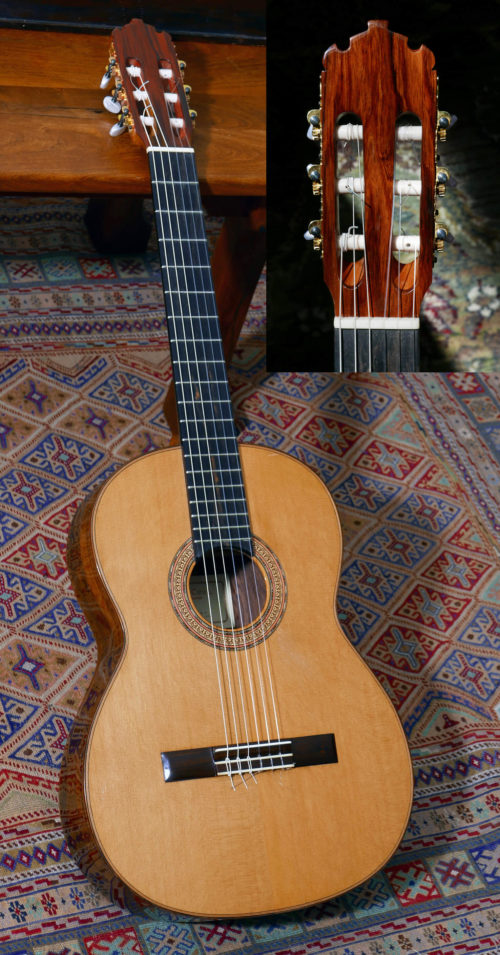 Acquired from the original owner – who bought this wonderful instrument directly from David Caro in the mountain town of the maker, one of the best luthiers that Paracho, Mexico has ever produced – in the mid 90’s and hand-carried it to California where it was lightly played. And it remains in remarkable original condition. The maker is David Caro, also known as David Caro Leonardo, or David Caro L. (In Mexico, the last/last name, in this case “Leonardo”, is the mother’s maiden name that is formally added after a person’s last [paternal] name but typically dropped in all but formal situations, documents etc.) Caro’s best instruments are among the best of a small, elite group that honed their craft at the top levels, and also benefited from visits and master classes given in Paracho by some world class luthiers from Spain, Germany, and the USA such as Felix Manzanero, Antonio Raya Pardo, Jose Romanillos, Thomas Humphery, and Herman Hauser III. Only a few Paracho luthiers have stood out over the years – Jose Navarro, Arturo Huipe, Abel Garcia, Enos Hernandez (his best work), German Vasquez Rubio, and Caro among them. See the enclosed photos from Fretboard Journal magazine, Spring 2008, that featured David Caro prominently in the feature article in that issue on Paracho luthiers. Paracho is an originally Tarascan village that sits in a high valley at 7,300 feet altitude, in the state of Michoacán, a relatively little visited state but renowned for its diversity and great beauty – and for some of the best classical guitar luthiers in the Americas. It extends from the Pacific coast, and is crossed by the Sierra Madre Del Sur in its southern part and by high volcanic mountains in its northern axis. When this guitar was made, in 1996, David Caro was at the height of his craft. And soon after, he was the first luthier to be added to the GSA calendar. This instrument is among the very best guitars ever made by Caro. And we love the model designation, it’s signed by hand on the label, “Mdo. 500”, i.e. “model 500” – sounds like a sports car name. Model 500 was the top model from Caro, in 1995/96 – using top woods, and also the best bindings, and all details. In those years, Caro’s best concert instruments went from model 100 at the base level, then ascending in tone woods and overall construction details to 200, 300, 400, then reaching the top level of “500”. So we’re calling this instrument, “el Quinientos”. (Spanish for “the 500” – nice ring to that – it’s pronounced “key-knee-éntose”) Several things make this guitar stand out as a gem: • It’s the top model from this luthier in the 1990’s • The great original condition • Scale length of 648mm. This scale length is reminiscent of Herman Hauser I’s guitars, and is firmly in the school of the shorter 650 range, not the longer scale lengths that crept in, in the last quarter of the 20th century. This is a great scale length – and note the nut width is a typical nut width of a full size classical guitar. And the neck thickness is great – on the thinner side. This combination makes it a joy to play and so easy to play – but the tone is superb. The full tone, and volume are better than most longer scale guitars. • Light weight/construction, that really allows it to sing. Its total weight, with strings, is a remarkably lithe 1430 grams • And it has great combination of woods: • Palo Escrito back and sides, bridge, and headplate veneer. DALBERGIA PALOESCRITO, is a true rosewood, a great wood that over the years came to be favored by the top luthiers in Paracho – for their top models. It sounds like Brazilian rosewood, but a tad different, and it’s not as “dark” in tone as Indian rosewood. Palo Escrito is lighter in weight and density than either brazilian or Indian rosewood. And weight, is of course part of the equation of a guitar that does translate to tone. Palo Escrito makes this guitar really breathe, and resonate. The lighter weight of this guitar is its charm, that translates to tone – slightly more airy and open, less “closed”, and with full round basses. The tone is clear, with superb string separation, as from the best spruce over rosewood guitars. Surprising volume – but it perhaps produces the best tone, in more delicate playing where you want each note to stand out – that’s of course called good “string separation”: the notes in a run or chord don’t all “blend together” but each note is discernable. And we think it’s accurate to say that this guitar, with its light weight and 648 scale length and combination of woods, has a tone that leans to a great Flamenco negra tone. Fast attack on the trebles, with a touch of growl in the bass when you play them hard. Yet the guitar responds very well to a light touch as well. If you’re looking for another ho-hum, non-descript spruce over Indian rosewood classical tone, this instrument is not for you. • Spruce top – European Alpine spruce • Ebony fingerboard • Ebony reinforcing strips, back of neck • Ebony heel cap • Beautiful rosette, with a hearts & rope pattern (another homage to Bernabe). • Palo Escrito is also used in the binding, back center strip, tie block, and purfling • The headstock shape is an homage to Paulino Bernabe. • Fan strutting, with 5 braces. The braces are very thin, and also scalloped – contributing to the great tone of the instrument. The scale length of the guitar, if it's not on the longer side, allows the luthier to be use more delicate bracing, adding to tone. (Longer scale length guitars produce more tension on the top due to the higher string tension inherent in a longer scale, so luthiers typically have to brace more strongly with longer scale lengths.) • And there is unique, 2-rosewood cleat application under the bridge – one cleat added by Caro at time of construction, on either end of the bridge, on the underside of top, for stability of the top wood beneath the bridge ends. It's worked well. • Good saddle height– and the neck is very straight, and there will never be any neck bowing issues or issue with too high action. Condition: 100% crack-free All original, thin lacquer finish Frets, and fretboard show very little wear A few nicks and dings, and a small amount of fingernail marks in the “pick guard” area. Overall, the condition is what you’d expect from an instrument that’s been played, carefully, for maybe a year, not 20+ years. But the tone is aged, open, clear – benefiting from more than two decades of aging and drying of the woods. Scale length: 648mm Nut Width: 52mm (2 2/32 inches) String spacing at nut: 45mm (1 ¾ inches) Width at lower bout: 14 ¼ inches Body depth, at bottom: 4 inches Body depth, at neck/body joint: 3 ¾ inches Weight (fully strung): 1430 grams (3.15 pounds) In a modern, hard shell case. Price: $4,750.
Acquired from the original owner – who bought this wonderful instrument directly from David Caro in the mountain town of the maker, one of the best luthiers that Paracho, Mexico has ever produced – in the mid 90’s and hand-carried it to California where it was lightly played. And it remains in remarkable original condition. The maker is David Caro, also known as David Caro Leonardo, or David Caro L. (In Mexico, the last/last name, in this case “Leonardo”, is the mother’s maiden name that is formally added after a person’s last [paternal] name but typically dropped in all but formal situations, documents etc.) Caro’s best instruments are among the best of a small, elite group that honed their craft at the top levels, and also benefited from visits and master classes given in Paracho by some world class luthiers from Spain, Germany, and the USA such as Felix Manzanero, Antonio Raya Pardo, Jose Romanillos, Thomas Humphery, and Herman Hauser III. Only a few Paracho luthiers have stood out over the years – Jose Navarro, Arturo Huipe, Abel Garcia, Enos Hernandez (his best work), German Vasquez Rubio, and Caro among them. See the enclosed photos from Fretboard Journal magazine, Spring 2008, that featured David Caro prominently in the feature article in that issue on Paracho luthiers. Paracho is an originally Tarascan village that sits in a high valley at 7,300 feet altitude, in the state of Michoacán, a relatively little visited state but renowned for its diversity and great beauty – and for some of the best classical guitar luthiers in the Americas. It extends from the Pacific coast, and is crossed by the Sierra Madre Del Sur in its southern part and by high volcanic mountains in its northern axis. When this guitar was made, in 1996, David Caro was at the height of his craft. And soon after, he was the first luthier to be added to the GSA calendar. This instrument is among the very best guitars ever made by Caro. And we love the model designation, it’s signed by hand on the label, “Mdo. 500”, i.e. “model 500” – sounds like a sports car name. Model 500 was the top model from Caro, in 1995/96 – using top woods, and also the best bindings, and all details. In those years, Caro’s best concert instruments went from model 100 at the base level, then ascending in tone woods and overall construction details to 200, 300, 400, then reaching the top level of “500”. So we’re calling this instrument, “el Quinientos”. (Spanish for “the 500” – nice ring to that – it’s pronounced “key-knee-éntose”) Several things make this guitar stand out as a gem: • It’s the top model from this luthier in the 1990’s • The great original condition • Scale length of 648mm. This scale length is reminiscent of Herman Hauser I’s guitars, and is firmly in the school of the shorter 650 range, not the longer scale lengths that crept in, in the last quarter of the 20th century. This is a great scale length – and note the nut width is a typical nut width of a full size classical guitar. And the neck thickness is great – on the thinner side. This combination makes it a joy to play and so easy to play – but the tone is superb. The full tone, and volume are better than most longer scale guitars. • Light weight/construction, that really allows it to sing. Its total weight, with strings, is a remarkably lithe 1430 grams • And it has great combination of woods: • Palo Escrito back and sides, bridge, and headplate veneer. DALBERGIA PALOESCRITO, is a true rosewood, a great wood that over the years came to be favored by the top luthiers in Paracho – for their top models. It sounds like Brazilian rosewood, but a tad different, and it’s not as “dark” in tone as Indian rosewood. Palo Escrito is lighter in weight and density than either brazilian or Indian rosewood. And weight, is of course part of the equation of a guitar that does translate to tone. Palo Escrito makes this guitar really breathe, and resonate. The lighter weight of this guitar is its charm, that translates to tone – slightly more airy and open, less “closed”, and with full round basses. The tone is clear, with superb string separation, as from the best spruce over rosewood guitars. Surprising volume – but it perhaps produces the best tone, in more delicate playing where you want each note to stand out – that’s of course called good “string separation”: the notes in a run or chord don’t all “blend together” but each note is discernable. And we think it’s accurate to say that this guitar, with its light weight and 648 scale length and combination of woods, has a tone that leans to a great Flamenco negra tone. Fast attack on the trebles, with a touch of growl in the bass when you play them hard. Yet the guitar responds very well to a light touch as well. If you’re looking for another ho-hum, non-descript spruce over Indian rosewood classical tone, this instrument is not for you. • Spruce top – European Alpine spruce • Ebony fingerboard • Ebony reinforcing strips, back of neck • Ebony heel cap • Beautiful rosette, with a hearts & rope pattern (another homage to Bernabe). • Palo Escrito is also used in the binding, back center strip, tie block, and purfling • The headstock shape is an homage to Paulino Bernabe. • Fan strutting, with 5 braces. The braces are very thin, and also scalloped – contributing to the great tone of the instrument. The scale length of the guitar, if it's not on the longer side, allows the luthier to be use more delicate bracing, adding to tone. (Longer scale length guitars produce more tension on the top due to the higher string tension inherent in a longer scale, so luthiers typically have to brace more strongly with longer scale lengths.) • And there is unique, 2-rosewood cleat application under the bridge – one cleat added by Caro at time of construction, on either end of the bridge, on the underside of top, for stability of the top wood beneath the bridge ends. It's worked well. • Good saddle height– and the neck is very straight, and there will never be any neck bowing issues or issue with too high action. Condition: 100% crack-free All original, thin lacquer finish Frets, and fretboard show very little wear A few nicks and dings, and a small amount of fingernail marks in the “pick guard” area. Overall, the condition is what you’d expect from an instrument that’s been played, carefully, for maybe a year, not 20+ years. But the tone is aged, open, clear – benefiting from more than two decades of aging and drying of the woods. Scale length: 648mm Nut Width: 52mm (2 2/32 inches) String spacing at nut: 45mm (1 ¾ inches) Width at lower bout: 14 ¼ inches Body depth, at bottom: 4 inches Body depth, at neck/body joint: 3 ¾ inches Weight (fully strung): 1430 grams (3.15 pounds) In a modern, hard shell case. Price: $4,750. -
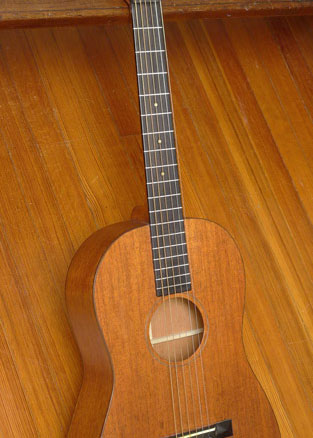 This is a very well made, custom Hawaiian guitar. Made by George Bailey, and signed and dated underside of top, 2009. The body style is similar to an early Ditson. In other regards, its size, sound, and feel is quite similar to a 1930’s Martin 0-17H.
This is a very well made, custom Hawaiian guitar. Made by George Bailey, and signed and dated underside of top, 2009. The body style is similar to an early Ditson. In other regards, its size, sound, and feel is quite similar to a 1930’s Martin 0-17H.- Mahogany back, sides, and top
- Mahogany neck
- Ebony fretboard
- Ebony bridge
- Flush frets, with raised nut and saddle, for Hawaiian playing
- Ladder braced
- Lower Bout width: 13 ¼ inches
- Scale length: 25 inches
- 1 ¾ inch nut
- Crack-free
-
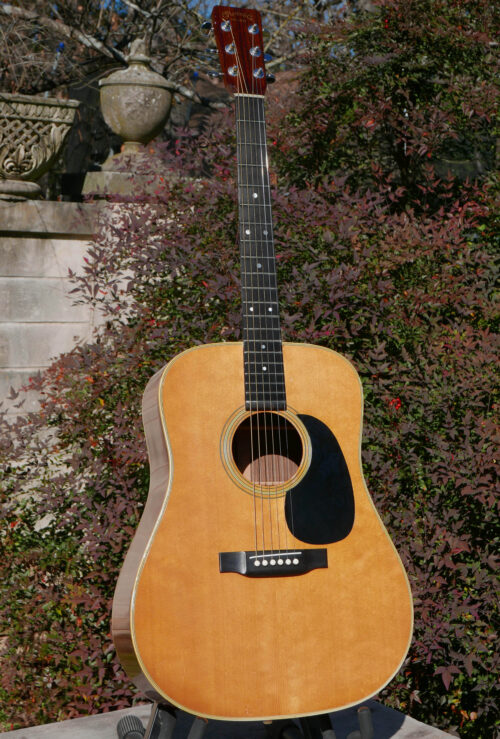 Martin D-28, made very early in 1970. Great tone, great original condition. • The finest, excellent quality Indian Rosewood back, sides, peghead veneer • Sitka Spruce top – and this is not the “streaky” sitka spruce. There are no dark streaks. Note light areas: that is “Bear claw”. • Ebony fingerboard and bridge. • Completely original. This guitar has had no repairs at all. • Original bridge, saddle, nut, pickguard • The guitar has no cracks, anywhere • Addition of a strap button on the neck heel. • Slight marks just above the nut, on bass side, caused from a strap that was worn under the strings on the peghead • The original Black Hard case (one of the last before Martin went to the Blue Plastic cases) is also very clean with no serious scrapes or bruises. One of the finest examples of 60s/early 1970 D28 available. Price: $5250.
Martin D-28, made very early in 1970. Great tone, great original condition. • The finest, excellent quality Indian Rosewood back, sides, peghead veneer • Sitka Spruce top – and this is not the “streaky” sitka spruce. There are no dark streaks. Note light areas: that is “Bear claw”. • Ebony fingerboard and bridge. • Completely original. This guitar has had no repairs at all. • Original bridge, saddle, nut, pickguard • The guitar has no cracks, anywhere • Addition of a strap button on the neck heel. • Slight marks just above the nut, on bass side, caused from a strap that was worn under the strings on the peghead • The original Black Hard case (one of the last before Martin went to the Blue Plastic cases) is also very clean with no serious scrapes or bruises. One of the finest examples of 60s/early 1970 D28 available. Price: $5250. -
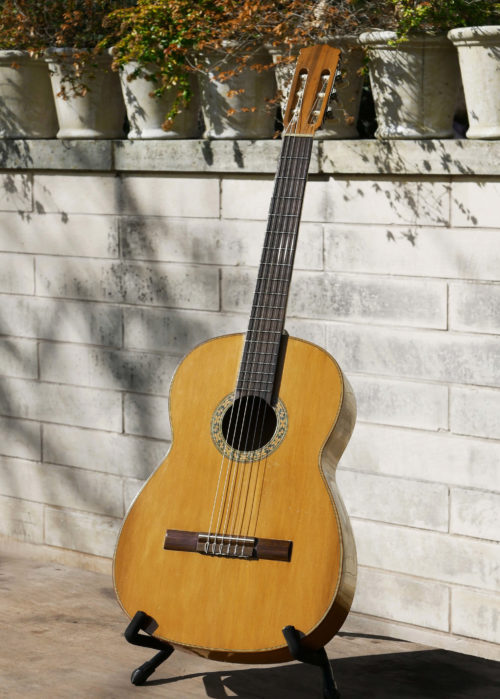 Another instrument from Enos Hernandez of Mexico, one of the best luthiers to ever live in work in Mexico, circa 1970’s. This one is a flamenco Blanca, with the classic cypress back and sides. Like the other Enos Hernandez we have, this one also has a cedar top. The instrument is super light weight, as a Flamenco Blanca should be, and it’s bright and percussive and raspy as a good Blanca should be. There is a scratch (not a crack) on back of guitar (see photo). There are dot position markers – original to the guitar, i.e. not added later – on top edge of fretboard (frets 3,5,7,9 – see photo). Scale length: 660mm Available January 2018 Price: $2950
Another instrument from Enos Hernandez of Mexico, one of the best luthiers to ever live in work in Mexico, circa 1970’s. This one is a flamenco Blanca, with the classic cypress back and sides. Like the other Enos Hernandez we have, this one also has a cedar top. The instrument is super light weight, as a Flamenco Blanca should be, and it’s bright and percussive and raspy as a good Blanca should be. There is a scratch (not a crack) on back of guitar (see photo). There are dot position markers – original to the guitar, i.e. not added later – on top edge of fretboard (frets 3,5,7,9 – see photo). Scale length: 660mm Available January 2018 Price: $2950 -
Out of stock
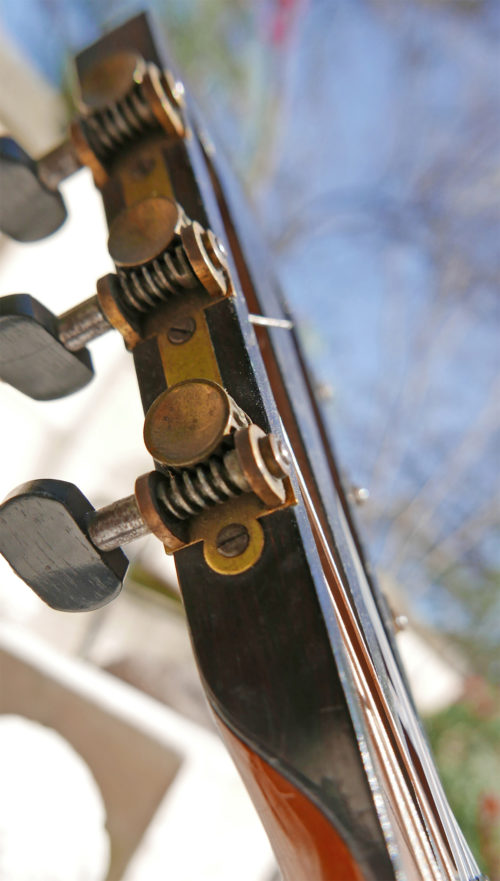 Circa 1860, style 3 guitar built by renowned luthier, James Ashborn of Wolcottville, CT, for William Hall & Son music store. Brazilian rosewood back and sides; Adirondack top; double maple binding (on both back, and front); original coffin case. This guitar is is 100% original, including all original finish, and down to original ebony nut, and original bridge (and saddle) that has never been off the guitar. And it comes in its original wood coffin case, as it left the factory around 1860. This James Ashborn style 3 is rare, and unique because it has brazilian veneer on the neck (not the fretboard which is ebony, but the back of neck), original to the guitar. And, that is very rare for any style/number Ashborn. Also unique to Ashborn’s style 3: his trademark hand-made tuners, have ebony buttons (not rosewood buttons as on his style 1, and 2) And this is a superb sounding Ashborn, unrivaled in tone by any 1850’s/1860’s American guitar we’ve seen and played, including any Martin from that era. Ashborn varied a few details on his guitars (styles 1,2,3, 5), but he did not vary the size of the guitars. He made them all the same body and neck size (unlike Martin for example). They are all the same size. And almost all had spruce/Brazilian veneer on back and sides. As this does. • Nut width is 1 7/8 inches • Width at lower bout: 11 3/8 inches • Scale Length: 24 inches • the action is 4/32 inch on both sides, at 12th string – normal action for this kind of guitar • There are repaired cracks on top, and back of guitar. All professionally repaired. James Ashborn was born in England circa 1816 and came to New England in the late 1830s. Ashborn had his shop in Torrington, but soon after start-up, he began selling guitars to the New York distributor William Hall & Son, whose name appears inside the instruments. From Vintage Guitar magazine: “Ashborn’s design for the guitar was quite innovative for the early 19th century. Instead of making guitars fashioned after the typical parlor-style guitars, he made them in the Spanish style, by taking interior bracing cues from the Spanish while retaining the body of the English guitars. This included a fan brace pattern rather than the more common ladder pattern Ashborn guitars have a very complex dovetail V joint for attaching the head to the neck. The headstock was cut in roughly five steps, using some kind of tracing router, as suggested by the chatter marks on the inside ears of the pegbox. In addition to the complex head design, Ashborn made his own tuning machines in-house. They’re made of brass, very much like contemporary machines, with worm gears, cog gears, and rollers. … Ashborn’s shop was extremely advanced for its time, having a great deal of know-how and technology. Ashborn understood the need to have the technology as well as the skill, but more importantly he discovered a new way of making high-quality instruments that were affordable. He was able to create a factory environment where workers did what they were good at and, with practice, became very fast and consistent. With a new level of consistency in mass production, he created the path followed by other companies such as Martin, Gibson, and Taylor. Using designs ahead of his time, he was able to bring the sound and change to people who otherwise never would have been able to acquire an instrument of this quality.” .... No longer available....
Circa 1860, style 3 guitar built by renowned luthier, James Ashborn of Wolcottville, CT, for William Hall & Son music store. Brazilian rosewood back and sides; Adirondack top; double maple binding (on both back, and front); original coffin case. This guitar is is 100% original, including all original finish, and down to original ebony nut, and original bridge (and saddle) that has never been off the guitar. And it comes in its original wood coffin case, as it left the factory around 1860. This James Ashborn style 3 is rare, and unique because it has brazilian veneer on the neck (not the fretboard which is ebony, but the back of neck), original to the guitar. And, that is very rare for any style/number Ashborn. Also unique to Ashborn’s style 3: his trademark hand-made tuners, have ebony buttons (not rosewood buttons as on his style 1, and 2) And this is a superb sounding Ashborn, unrivaled in tone by any 1850’s/1860’s American guitar we’ve seen and played, including any Martin from that era. Ashborn varied a few details on his guitars (styles 1,2,3, 5), but he did not vary the size of the guitars. He made them all the same body and neck size (unlike Martin for example). They are all the same size. And almost all had spruce/Brazilian veneer on back and sides. As this does. • Nut width is 1 7/8 inches • Width at lower bout: 11 3/8 inches • Scale Length: 24 inches • the action is 4/32 inch on both sides, at 12th string – normal action for this kind of guitar • There are repaired cracks on top, and back of guitar. All professionally repaired. James Ashborn was born in England circa 1816 and came to New England in the late 1830s. Ashborn had his shop in Torrington, but soon after start-up, he began selling guitars to the New York distributor William Hall & Son, whose name appears inside the instruments. From Vintage Guitar magazine: “Ashborn’s design for the guitar was quite innovative for the early 19th century. Instead of making guitars fashioned after the typical parlor-style guitars, he made them in the Spanish style, by taking interior bracing cues from the Spanish while retaining the body of the English guitars. This included a fan brace pattern rather than the more common ladder pattern Ashborn guitars have a very complex dovetail V joint for attaching the head to the neck. The headstock was cut in roughly five steps, using some kind of tracing router, as suggested by the chatter marks on the inside ears of the pegbox. In addition to the complex head design, Ashborn made his own tuning machines in-house. They’re made of brass, very much like contemporary machines, with worm gears, cog gears, and rollers. … Ashborn’s shop was extremely advanced for its time, having a great deal of know-how and technology. Ashborn understood the need to have the technology as well as the skill, but more importantly he discovered a new way of making high-quality instruments that were affordable. He was able to create a factory environment where workers did what they were good at and, with practice, became very fast and consistent. With a new level of consistency in mass production, he created the path followed by other companies such as Martin, Gibson, and Taylor. Using designs ahead of his time, he was able to bring the sound and change to people who otherwise never would have been able to acquire an instrument of this quality.” .... No longer available.... -
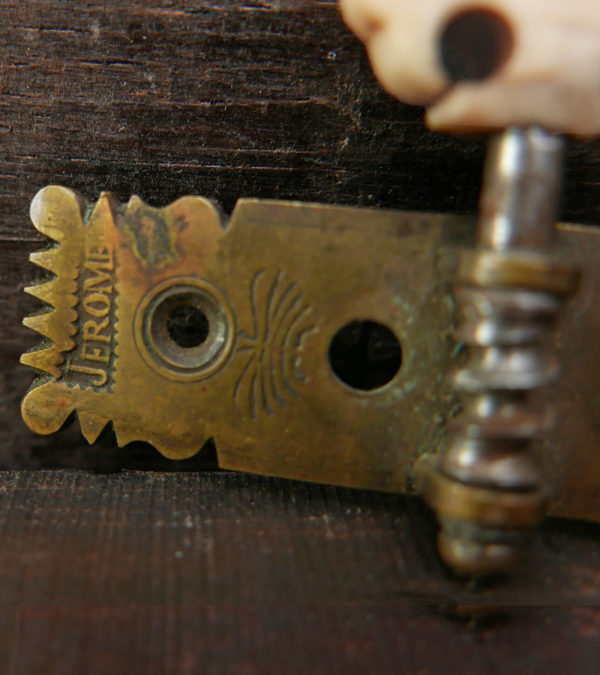 Very rare, early Jerome guitar tuners, made in France. Rare kidney buttons, as seen on higher end Martin guitars from the 1840s, 1850s, and 1860's. Plates, shafts and buttons only. No posts or worm gears (there is one post and one worm gear). Price: $595.
Very rare, early Jerome guitar tuners, made in France. Rare kidney buttons, as seen on higher end Martin guitars from the 1840s, 1850s, and 1860's. Plates, shafts and buttons only. No posts or worm gears (there is one post and one worm gear). Price: $595. -
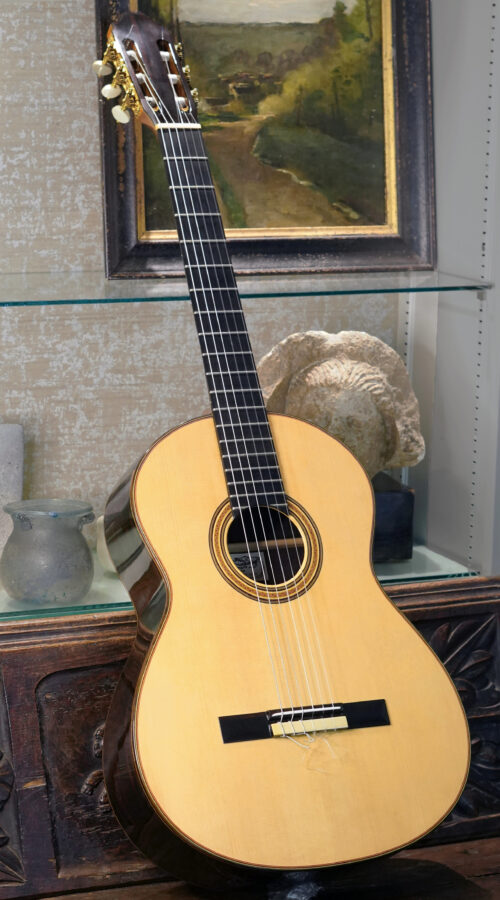 Ken Miller, a great and meticulous luthier, is now retired and is not taking any guitar orders. He started building in early 1960s and in the 1970’s worked at Guild Guitars in Rhode Island, in a variety of positions. He was a full-time luthier with his own brand of guitars from 1999 until retirement in 2015. His guitars are hard to come by – especially his classical guitars as he made only a small number of classicals over the years. “I made all of my Classical and Flamenco guitars in 650mm scale, and with the body size and shape of this one,” said Ken in a recent conversation with us. “The Flamenco guitars had slightly different internals, lower bridge and were made with Spanish Cypress back & sides, and friction pegs. All I made, classical or flamenco, were 650mm scale. I think that those Spanish instruments from about 1900 through the '30's were the cream of the crop. I don't care for the modern, larger classical guitars… My two guitar heroes were Santos Hernandez, and CF Martin.” See/listen to a recording of this guitar being played, in the video posted here. This classical guitar is 20 years old, but you can’t tell by looking at it, it’s near pristine in terms of play wear. It has a big, rich, lush sound. It really excels in the ringing Brazilian rosewood trebles. And it’s one of the few guitars you’ll find where you can get incredible nuance with just a light touch. • Serial number: #70, made in 2003. (Signed as such on label) • Old growth, dark Brazilian Rosewood back/sides, head plate overlay, binding and bridge. (Note, a few “eyes” in the Brazilian on back, were wormholes in the very dark, very old Brazilian that the luthier very well plugged before putting the guitar together.) • The top, and internal bracings are Adirondack (Red) Spruce • There are 7 slender fan braces with a thin horizontal brace under the bridge area between braces 1 and 7 • Ebony fingerboard • Spanish Cedar internal lining as is the neck which has a graphite reinforcement. Fitted to the body with a traditional Spanish foot. • Nut, saddle & bridge tie plate are Fossil Ivory. • Nut is 51.5mm • 650mm scale • Handmade rosette • Oil varnish finish • Gotoh Deluxe tuners with Ivoroid tuner buttons There is one, very small crack that’s difficult to see/photograph on the back of the guitar near the center seam that is near the area of the end pin. The top of the guitar, with no cracks whatsoever, looks virtually unplayed, as does the fretboard and frets. This guitar sold for $6,000 new, in 2003, and it’s about as close to that original ’03 condition as you can get. With its very dark, old growth Brazilian rosewood, it’s easily comparable in build quality, materials, and sound, to classicals in the $8-14K range today. Price: $4,850. With modern case.
Ken Miller, a great and meticulous luthier, is now retired and is not taking any guitar orders. He started building in early 1960s and in the 1970’s worked at Guild Guitars in Rhode Island, in a variety of positions. He was a full-time luthier with his own brand of guitars from 1999 until retirement in 2015. His guitars are hard to come by – especially his classical guitars as he made only a small number of classicals over the years. “I made all of my Classical and Flamenco guitars in 650mm scale, and with the body size and shape of this one,” said Ken in a recent conversation with us. “The Flamenco guitars had slightly different internals, lower bridge and were made with Spanish Cypress back & sides, and friction pegs. All I made, classical or flamenco, were 650mm scale. I think that those Spanish instruments from about 1900 through the '30's were the cream of the crop. I don't care for the modern, larger classical guitars… My two guitar heroes were Santos Hernandez, and CF Martin.” See/listen to a recording of this guitar being played, in the video posted here. This classical guitar is 20 years old, but you can’t tell by looking at it, it’s near pristine in terms of play wear. It has a big, rich, lush sound. It really excels in the ringing Brazilian rosewood trebles. And it’s one of the few guitars you’ll find where you can get incredible nuance with just a light touch. • Serial number: #70, made in 2003. (Signed as such on label) • Old growth, dark Brazilian Rosewood back/sides, head plate overlay, binding and bridge. (Note, a few “eyes” in the Brazilian on back, were wormholes in the very dark, very old Brazilian that the luthier very well plugged before putting the guitar together.) • The top, and internal bracings are Adirondack (Red) Spruce • There are 7 slender fan braces with a thin horizontal brace under the bridge area between braces 1 and 7 • Ebony fingerboard • Spanish Cedar internal lining as is the neck which has a graphite reinforcement. Fitted to the body with a traditional Spanish foot. • Nut, saddle & bridge tie plate are Fossil Ivory. • Nut is 51.5mm • 650mm scale • Handmade rosette • Oil varnish finish • Gotoh Deluxe tuners with Ivoroid tuner buttons There is one, very small crack that’s difficult to see/photograph on the back of the guitar near the center seam that is near the area of the end pin. The top of the guitar, with no cracks whatsoever, looks virtually unplayed, as does the fretboard and frets. This guitar sold for $6,000 new, in 2003, and it’s about as close to that original ’03 condition as you can get. With its very dark, old growth Brazilian rosewood, it’s easily comparable in build quality, materials, and sound, to classicals in the $8-14K range today. Price: $4,850. With modern case. -
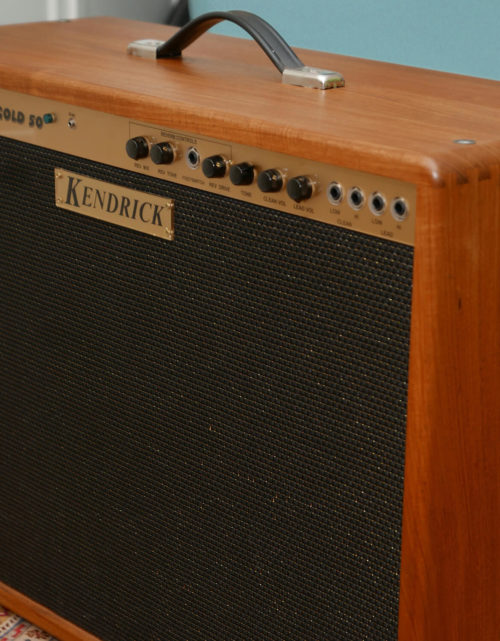 This was one of the best amps ever made by the legendary Gerald Weber. All-tube circuitry, designed and made in the USA, by Weber. It not only has power to spare (50 watts), but its unique circuitry has two channels, clean and lead, with different preamp circuit. These channels can be blended through patching the second input of one channel into the first input of the other, for purposes of blending the two channels together and further tone shaping with the interactive tone circuit. The bottom line: Tons of power if you need it, but the ability to get all the creamy, lush lead tones with the lead channel and/or blending. You just have to hear it. Original, handmade hardwood cabinet. 2 x 12: one 12 inch Kendrick brown frame and one 12 inch Kendrick black frame speaker. Kendrick's double spring reverb with three controls. Great condition. Recently serviced by one of the best amp techs in Texas. Price: $1495. No shipping. Local pickup only in Austin.
This was one of the best amps ever made by the legendary Gerald Weber. All-tube circuitry, designed and made in the USA, by Weber. It not only has power to spare (50 watts), but its unique circuitry has two channels, clean and lead, with different preamp circuit. These channels can be blended through patching the second input of one channel into the first input of the other, for purposes of blending the two channels together and further tone shaping with the interactive tone circuit. The bottom line: Tons of power if you need it, but the ability to get all the creamy, lush lead tones with the lead channel and/or blending. You just have to hear it. Original, handmade hardwood cabinet. 2 x 12: one 12 inch Kendrick brown frame and one 12 inch Kendrick black frame speaker. Kendrick's double spring reverb with three controls. Great condition. Recently serviced by one of the best amp techs in Texas. Price: $1495. No shipping. Local pickup only in Austin. -
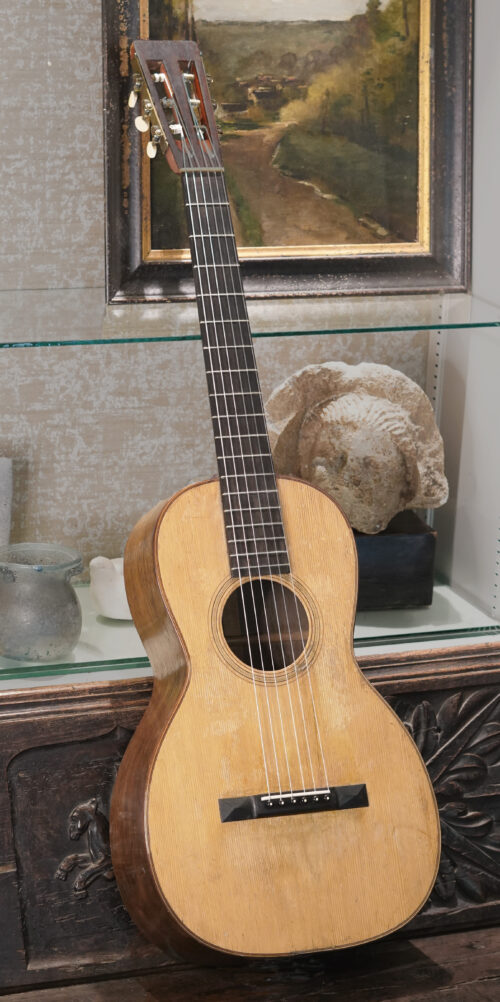
In this period, the Martin factory foreman often wrote the date of manufacture, before the guitar left the factory, hand-written in pencil on the underside of the top. This one has hand-written inside "5 / 1886". It’s a nice touch to a great Martin – and the size 2 is a great size, it’s a larger guitar than the more common size 2 ½ from this era.
Exquisite tone from this guitar. See and hear this guitar being played:
All careful work has been done on this guitar, including a perfect ebony bridge by T.J. Thompson, and it won’t need anything else. It’s an ideal guitar for the player who wants the best Martin tone and playability – a tonal gem from the 19th century Martin factory in Nazareth.
• Slot head, with original geared tuners
• Spruce top over Brazilian Rosewood back and sides.
• All original finish, with the exception of some minor touch up in the bridge area.
• Perfect reproduction ebony, pyramid bridge by T.J. Thompson.
Some touch-up in the bridge area of the spruce when the bridge was fitted.
• Fan braced – as are most of the best sounding Martins from this era.
• Original thin maple bridge plate, that has had some minor pin hole attention, by us, to ensure stability and protection from ball ends.
• Original ebony fretboard; Original bar frets. Frets have some wear, but we left them, for originality, and they play fast and low and smooth.
• Spanish heel (not the ice cream cone heel of the less expensive Martins of the era).
• Soft V neck
• End pin is original, tab end of the pin has come off but the shaft remains
• One inch area in the rosette, repaired (see photos)
• Three tiny holes near end pin are remnant of a tailpiece used at some point in the previous century
• One crack on top, just below the low E string (see photos). About 4 1/2 inches long. This crack has been glued, and is tight (no cleat due to proximity to a brace).
• Scale length: 24.5 inches
• Width at lower bout: 12 inches
• Nut width: 1 13/16 inch
The guitar has had a recent neck set (by us), so the action is great, and lower than what a lot of folks try to get away with on a 19th century Martin. This guitar does not have “classical guitar action.” The great Martins from this era were not then and they should not today be considered “classical guitars”. They are parlor guitars, and the best examples have the Martin sound we know and love, with a “classical” sound if we consider that sound from the 19th century not today.
No excuses on the action, tone, and playability on this guitar. Strung with Savarez Alliance strings. It plays so easily, with perfect intonation all the way up the fretboard, and the sound is stellar.
It ships in a modern hard shell case.
Price: $6,750. – plus shipping
-
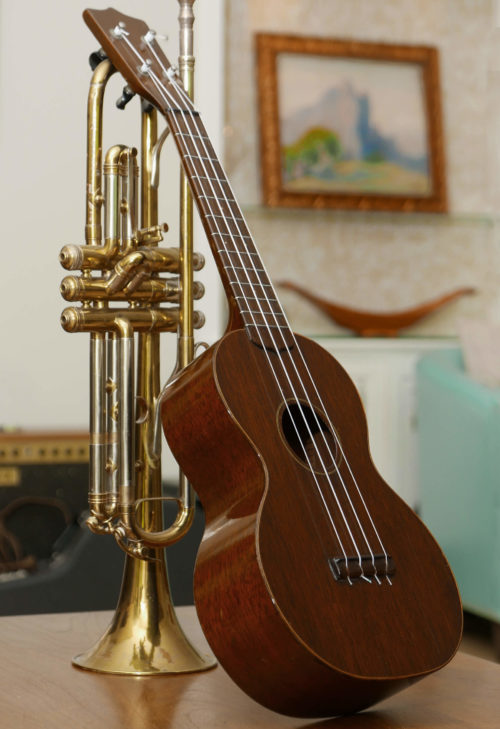 A beautiful example of one of the rarest prewar Martin ukuleles. This is a prewar Martin C-1. (All Concert Model ukuleles from Martin– with the exception of few special orders– were style 1). Officially called the Concert model ukulele, it’s larger than the many soprano size ukes. It’s very rare to find a prewar C-1 on the market– and much rarer still to find a pre-1933. This instrument was made between 1925 and 1933– because of the Martin stamp on the back of the headstock and the lack of the (post-1933) Martin decal on the front of the headstock. This is currently the only Martin C-1 from the late 1920’s on the market. And the tone and playability are perfect. Louder, and more bell like tone than a Martin Style 1 soprano uke. Martin concert ukuleles are the same body size as taropatch (1918-1932) but with four strings only. While the taropatch had been offered with four strings since its introduction, the new concert model was different in that it had a narrower neck and a standard soprano-size bridge. It was added to the standard catalog that year and by 1927 it was outselling all taropatch models combined. Concerts ukuleles are tuned the same as the sopranos but because of the larger body have a deeper and richer sound, and a slightly longer, easier to play scale length of 14 3/4". The Concert Ukulele from Martin–while rare to find a prewar example– is considered the ideal size for players– larger than the tiny soprano but not too big like the Martin Tenor uke. This one has a rich, beautiful tone, and it’s almost unplayed condition. The action is perfect. There is one small crack on top–but it’s essentially “cleated” by the orignal bridde plate and does not need addressing, and a smaller finish crack that does not go through to the inside). The braces and all else inside: pristine. And it even comes in its original canvas case. Like most Martin ukes, the mahogany bridge had some wear on the string slots. So we created a new, replacement, 100% historically correct replacement bridge. Original patent tuners Original ebony nut Brazilian rosewood fretboard Style 1: all mahogany, with brazilian binding on top Total length: 23 ¼ inches Body length: 11 inches Body width upper bout: 5 ¾ inches Body width lower bout: 7 5/8 inches Scale length: 14 ¾ inches Price: with original case. $2150.
A beautiful example of one of the rarest prewar Martin ukuleles. This is a prewar Martin C-1. (All Concert Model ukuleles from Martin– with the exception of few special orders– were style 1). Officially called the Concert model ukulele, it’s larger than the many soprano size ukes. It’s very rare to find a prewar C-1 on the market– and much rarer still to find a pre-1933. This instrument was made between 1925 and 1933– because of the Martin stamp on the back of the headstock and the lack of the (post-1933) Martin decal on the front of the headstock. This is currently the only Martin C-1 from the late 1920’s on the market. And the tone and playability are perfect. Louder, and more bell like tone than a Martin Style 1 soprano uke. Martin concert ukuleles are the same body size as taropatch (1918-1932) but with four strings only. While the taropatch had been offered with four strings since its introduction, the new concert model was different in that it had a narrower neck and a standard soprano-size bridge. It was added to the standard catalog that year and by 1927 it was outselling all taropatch models combined. Concerts ukuleles are tuned the same as the sopranos but because of the larger body have a deeper and richer sound, and a slightly longer, easier to play scale length of 14 3/4". The Concert Ukulele from Martin–while rare to find a prewar example– is considered the ideal size for players– larger than the tiny soprano but not too big like the Martin Tenor uke. This one has a rich, beautiful tone, and it’s almost unplayed condition. The action is perfect. There is one small crack on top–but it’s essentially “cleated” by the orignal bridde plate and does not need addressing, and a smaller finish crack that does not go through to the inside). The braces and all else inside: pristine. And it even comes in its original canvas case. Like most Martin ukes, the mahogany bridge had some wear on the string slots. So we created a new, replacement, 100% historically correct replacement bridge. Original patent tuners Original ebony nut Brazilian rosewood fretboard Style 1: all mahogany, with brazilian binding on top Total length: 23 ¼ inches Body length: 11 inches Body width upper bout: 5 ¾ inches Body width lower bout: 7 5/8 inches Scale length: 14 ¾ inches Price: with original case. $2150. -
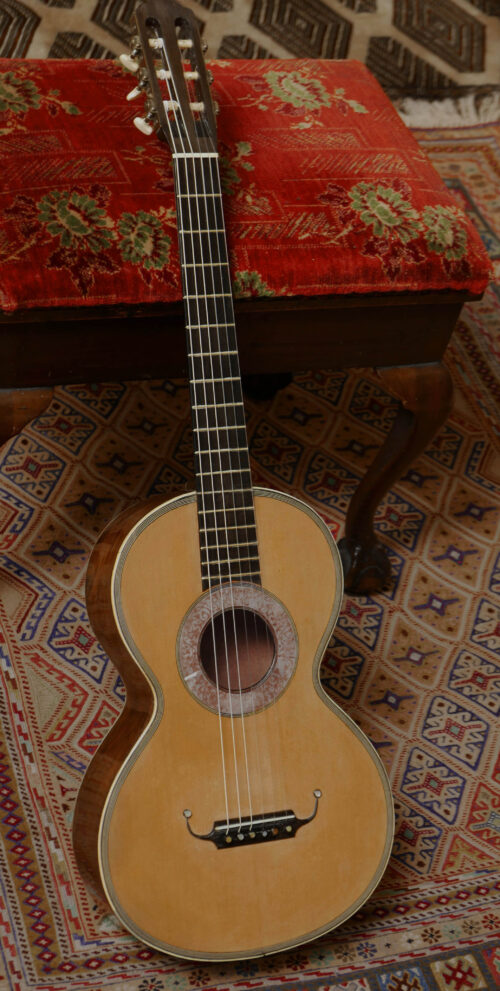 Pierre Marcard, well-known luthier in France, 1794-1867. This guitar is from about 1845–1850. Signed with the maker’s stamp/signature on inside, back (see photo). • All original: finish, bridge, frets, endpin, everything • Spruce top • Ebony bridge • Finely decorated mother of pearl rosette • Brazilian rosewood/maple laminate back • Solid Brazilian rosewood sides (note this is rare: solid, it was an upgrade from the standard practice of the day to do laminate sides as well. • Scale length: 632mm • Nut width: 46mm You can see a sound/video clip of this guitar being played, here: https://www.youtube.com/watch?v=Ryf25bMcmt4 Condition: Amazing original condition. • Similar to other fine guitars of that era, from Lacote and others, the "finish" on the top of the guitar – still all original finish and unmolested – is super thin. Those master French luthiers thought that less finish on top, was better. • No cracks on top, back, sides • A few tiny and superficial surface “cracks” on a few sections of binding • Bridge, all original, has never been off the instrument. Saddle looks original. The bridge does have a few cracks in the ebony, parallel to the length of the bridge. We have left them as is, for originality (a luthier might fill in the tiny gaps with ebony paste – the structure/integrity of the bridge is good.) • The bridge pins look original to the guitar, but hard to verify that. • Action of the guitar is good, consistent with mid nineteenth century standards. • Tone of the guitar, is excellent. Good projection for this sized instrument. Playability is very good– with good intonation even at high registers. Price: $8250. Will ship in a modern hard shell case.
Pierre Marcard, well-known luthier in France, 1794-1867. This guitar is from about 1845–1850. Signed with the maker’s stamp/signature on inside, back (see photo). • All original: finish, bridge, frets, endpin, everything • Spruce top • Ebony bridge • Finely decorated mother of pearl rosette • Brazilian rosewood/maple laminate back • Solid Brazilian rosewood sides (note this is rare: solid, it was an upgrade from the standard practice of the day to do laminate sides as well. • Scale length: 632mm • Nut width: 46mm You can see a sound/video clip of this guitar being played, here: https://www.youtube.com/watch?v=Ryf25bMcmt4 Condition: Amazing original condition. • Similar to other fine guitars of that era, from Lacote and others, the "finish" on the top of the guitar – still all original finish and unmolested – is super thin. Those master French luthiers thought that less finish on top, was better. • No cracks on top, back, sides • A few tiny and superficial surface “cracks” on a few sections of binding • Bridge, all original, has never been off the instrument. Saddle looks original. The bridge does have a few cracks in the ebony, parallel to the length of the bridge. We have left them as is, for originality (a luthier might fill in the tiny gaps with ebony paste – the structure/integrity of the bridge is good.) • The bridge pins look original to the guitar, but hard to verify that. • Action of the guitar is good, consistent with mid nineteenth century standards. • Tone of the guitar, is excellent. Good projection for this sized instrument. Playability is very good– with good intonation even at high registers. Price: $8250. Will ship in a modern hard shell case. -
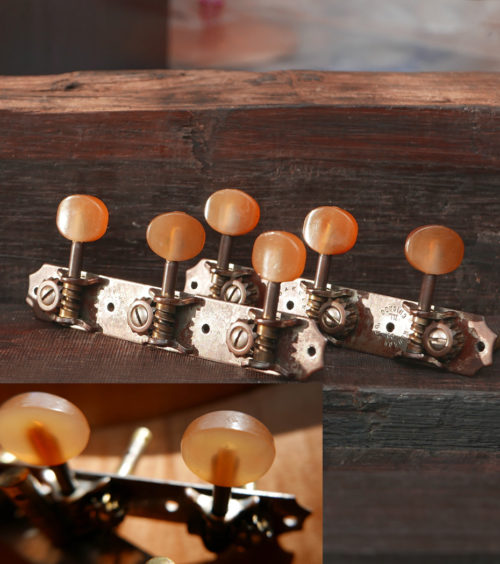 Pre-war Kluson tuners from the 1930's. Amber buttons. These are rare tuners that came on some of the nice Gibsons of the era, such as a few Gibson J35's. Good working condition. Price: $295. – on Hold
Pre-war Kluson tuners from the 1930's. Amber buttons. These are rare tuners that came on some of the nice Gibsons of the era, such as a few Gibson J35's. Good working condition. Price: $295. – on Hold